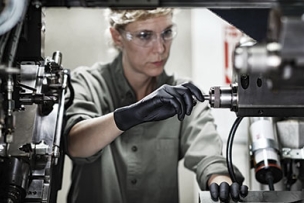Ansell is a global supplier of personal protection (PPE) equipment solutions designed for workers in a wide range of industries. Ansell's customers include businesses engaged in the Manufacturing, Agriculture, Healthcare and Scientific sectors, as well as many other business sectors. Ansell has developed a global presence that includes sales, operations and manufacturing sites in North America, Latin America, Europe and Asia and employs more than 15,000 people worldwide. Ansell's position as a market leader has evolved over more than 100 years of history and can be attributed to our history of providing innovative protection solutions to workers through a deep understanding of the worker experience.
Eye protection is intended to act as a barrier to infectious materials entering the eye, to reduce the risk of exposure to the novel coronavirus. Eye protection is used in conjunction with other Personal Protective Equipment (PPE) such as gloves, gowns and face masks or respirators, and like all PPE care must be taken when donning and doffing.
Eye protection PPE1 includes:
Indirectly-vented Goggles
CDC/NIOSH states: “Appropriately fitted, indirectly-vented goggles* with a manufacturer’s anti-fog coating provide the most reliable practical eye protection from splashes, sprays, and respiratory droplets. Many styles of goggles fit adequately over prescription glasses with minimal gaps. However, to be efficacious, goggles must fit snugly, particularly from the corners of the eye across the brow. While highly effective as eye protection, goggles do not provide splash or spray protection to other parts of the face.
* Directly-vented goggles may allow penetration by splashes or sprays; therefore, indirectly-vented or non-vented goggles are preferred for infection control.
Face Shields
CDC/NIOSH states: “Face shields are commonly used as an infection control alternative to goggles.** As opposed to goggles, a face shield can also provide protection to other facial areas. To provide better face and eye protection from splashes and sprays, a face shield should have crown and chin protection and wrap around the face to the point of the ear, which reduces the likelihood that a splash could go around the edge of the shield and reach the eyes. Disposable face shields for medical personnel made of light weight films that are attached to a surgical mask or fit loosely around the face should not be relied upon as optimal protection.
** In a chemical exposure or industrial setting, face shields should be used in addition to goggles, not as a substitute for goggles (ANSI Z87.1-2003 Practice for occupational and educational eye and face protection).”
Full Face Respirators
CDC/NIOSH states: “Full facepiece elastomeric respirators and powered air purifying respirators (PAPRs) are designed and used for respiratory protection, but because of their design incidentally provide highly effective eye protection as well. Selection of this type of PPE should be based on an assessment of the respiratory hazard in an infection control situation, but will also provide, as an additional benefit, optimal eye protection.”








Talk to Us!
Leave a reply
Your email address will not be published. Required fields are marked *